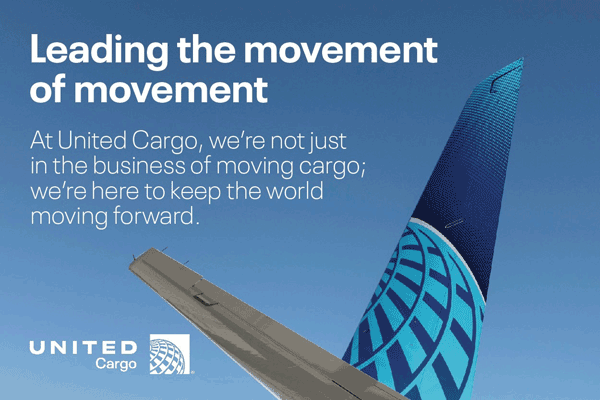
 |
 |
 #INTHEAIREVERYWHERE |
| Vol. 22 No. 27 Bulldog Edition | Friday
August 11,
2023 |
| |
 |
Bill Boesch thinks about life and the air cargo business all the time. A top logistician with deep roots in upper management everywhere, Bill has served, including most recently as a go-to resource in logistics for the U.S. military. Bill was thinking about the state of affairs of the global freighter market. He is not surprised, mind you, of the general malaise of action for freighters in 2023. In fact, the man, who reviewing the global air cargo market once commented that he believes that it has been too long that in air cargo, an industry which is not yet fully defined, innovation has been mostly swept under the rug. “The last truly dramatic and great change in air cargo occurred a half century ago when Fred Smith invented FedEx,” Bill Boesch said. Amazon has also created new markets for air cargo through its shopping network. But the man who led the charge at American Airlines Cargo, Emery and Seaboard into global expansion, and was instrumental in delivering Envirotainer into business is thinking right now about what happened to the U.S. freighter business that has come in for a hard landing this year. “In the movie The Perfect Storm, the fishing vessel Andrea Gail and its Captain Billy Tyne and crew in 1991, finds itself trapped in a situation aboard an ill-fated commercial swordfish fishing vessel, where everybody is lost at sea,” Bill said. “Unfortunately, that movie, which popped up on my TV screen recently raises, at least for me, an image of the present-day air cargo freighter carriers’ situation. “During the pandemic widebody international passenger flights, which traditionally carried 60% of the world's air cargo, were mostly grounded. “As a result, the Air Freight Forwarders and the large commercial shippers had to rely on the air cargo freighter carriers. “These carriers took advantage of this situation by expanding their operations and charging high rates for ACMI (Aircraft, Crew, Maintenance and Insurance) leases to maximize their profits. “When the pandemic ended and the international widebody passenger aircraft returned, a ‘Perfect Storm’ hit these carriers as also at the same time the air cargo market declined. “This 2023 Perfect Storm in the air cargo industry, with the passenger widebody aircraft returning, has resulted in less cargo for the freighter carriers and a subsequent major reduction in air cargo rates. “The other downside driver in all of this is higher wages and higher fuel costs the carriers are experiencing. This coupled with the lower volume and rates has resulted in the freighter carriers operating under extreme pressure on their profits. “Many of these carriers are trying to shed their costs, refinance their debt and are aggressively offering ACMI guaranteed leases for their aircraft.” So can anybody see a happy ending? Bill thinks no one should hold their breath. Add to that higher interest rates for money, which many of these carriers need. The U.S. dollar appreciated over 12% in 2022, hitting a two-decade high in September 2022. The high value of the U.S. dollar has favored U.S. imports. Bill says: “The high U.S. dollar value resulted in U.S. importers relying more on the non-U.S. freighter carriers which are less expensive than those carriers operating under the U.S. dollar. “Some freighter carriers may end up adrift, possibly lost forever as they struggle to reduce their costs to achieve profitability while awaiting either government assistance, which is unlikely, or better weather,” Bill Boesch said. Geoffrey |
Shesh Kulkarni, Managing Director, India, Noatum Logistics is an air cargo veteran. Noatum is a leading supply chain management company with global coverage, specializing in freight management, international supply chain management, contract logistics, project logistics, eSolutions, and customs and clearance. FT: Let’s have a look at 2023. With your immense experience, how has the air cargo landscape changed after the Covid pandemic in the country? Shesh Kulkarni: The last two years, i.e., starting mid-2020 to December 2022, the cargo industry has been on a roller coaster ride. Pre-Covid, rates were very low and post-Covid for almost two years freight rates went through the roof. In certain instances, freight rates were 12 to 13 times higher than the pre-Covid times and added to it, was the nuisance of equipment shortfall. However, in the last four months of 2022 the rates dramatically dropped and reached pre-Covid levels. There were further drops as many shipping lines and airlines started adding capacity on key routes. As China slowly opened in 2022, all the equipment that was stuck in the interiors of China found its way back to the mainstream. The first half of 2023 has been a trying time for all freight companies, airlines, and shipping lines, as everyone hustled to re-calibrate. FT: Cargo has become the main driver for many airlines to make money. How do you see the air cargo business shaping up despite the challenges it faces? SK: It is true, cargo made it to the centre stage which in one way, is very good. That is how it should be always. In logistics, the service providers, carriers, and all those engaged and involved in supporting the process are key and must get their dues. In my personal view, cargo will still play second fiddle to passenger capacity in the aviation sector. There has been a readjustment and a large section of mainstream carriers (Airlines) did not rush to deploy freighters. They will instead continue to use the belly capacity. Simply put, 2023 seems a challenging year for now. FT: With freight rates, how do you see the current scenario? SK: The landscape changed dramatically in the last three months of 2022 It looked different in the early 2022 through mid-2022. The current freight rates both air and sea are down big time. It is now the shippers and consignees market. The customers who have business will go around in circles around the industry. There will be a long-term impact. FT: The Indian government’s plans to boost international and domestic cargo has yielded results. Would you like the government to further enhance its role and take more initiatives to boost cargo from the country? SK: It is evident that India will be the frontrunner and it will be the beneficiary in the long run. The government of India is doing everything to attract industries and investments. There is a shift of certain volumes from China to India but to match China’s capacity is not an easy task. China over 30 years has built a very robust infrastructure and the policy. India’s “Aatmanirbhar” (self-reliant) policy is gaining momentum. But, building infrastructure and capacity, is a 10-to-15-year cycle. Hence, we will see the results of the government’s work post-2028/2030. Needless to say, the government is on top of their game. They have built—and continue to build—wonderful infrastructure, airports and ports. The road infrastructure is getting better day-by-day. Freight corridors and highways are good and adding immense value. The Customs processing times has dramatically reduced and is at par with international standards. With all this, the list of positives is only growing. The only negative, I see, is the cost of sourcing capital in India, which is still prohibitive. India’s domestic economy is holding well. Consumer demand is growing and the government is investing in mega projects, which is good for the Indian industry. The growth of domestic economy is benefitting Indian companies, and as a result imports have gone up, which are largely sourced from China. This because Indian manufacturing is not geared up to take bigger orders and meet price points. With growing automation in the industry, the last mile operators will be game changers. The logistic industry has been adopting digitalization extensively, which is the need of the hour. Artificial Intelligence, Machine Learning are all becoming integral part of last-mile delivery. FT: As an air cargo frontliner, do you think the time has come to actively start work of creating air cargo hubs that we have all been thinking for a long time? SK: In the coming 5 years, we will see multiple air cargo hubs operational and functioning in India. We will see a few in the South, West and in North. If you visit Bangalore airport, one will be amazed to see how futuristic the infrastructure will be, once it is ready. Bangalore is the Gateway to the South and will remain so. Tirthankar Ghosh |
 |
 We
write about women in air cargo, about female aviators, and because we acknowledge
women as consummate multi-taskers, we must remember to ask: what else can
you do? What else do you do? We
write about women in air cargo, about female aviators, and because we acknowledge
women as consummate multi-taskers, we must remember to ask: what else can
you do? What else do you do? Invariably, women in every industry perform several and various functions in order not to go ‘hysterical,’ a term loved dearly by detractors of feminists like Betty Friedan as it improperly classified and deflected from that general feeling of malaise suffered by so many women who were not put to good use beyond the home. As lovers of all things historical and otherwise, FlyingTypers recently came across an intriguing vintage image of two baby-faced planes rendered in bright primary colors, soaring through the sky against a tilted horizon and setting orange sun. When we say baby-faced, we don’t mean that euphemistically, as if the planes are just a few days old. The planes, quite literally, have baby faces—round, cherubic, ruddy-cheeked, with milk saucer eyes and gold-plaited hair. Stylistically it’s very reminiscent of the Max Fleischer cartoons of the 30s and 40s.  The
children’s book Air Babies was written and illustrated by
a young woman named Elvy Kalep, and at first glance that statement seems
like nothing special. But upon further examination and exploration, we realized
that Kalep was not just or only a children’s book author—she
was also an aviator. And not just any aviator, but the first female in Estonia
to receive a pilot’s license, in 1931. A year later, in May 1932,
Kalep traveled to the United States with the intention of flying back to
Europe—essentially to attempt a solo transatlantic flight. Unbeknownst
to her, another woman had her eye on that particular feat—Amelia Earhart.
The two became friends, and Earhart performed the first solo transatlantic
flight later that month, which put Kalep off of the idea as she would no
longer be the first. The
children’s book Air Babies was written and illustrated by
a young woman named Elvy Kalep, and at first glance that statement seems
like nothing special. But upon further examination and exploration, we realized
that Kalep was not just or only a children’s book author—she
was also an aviator. And not just any aviator, but the first female in Estonia
to receive a pilot’s license, in 1931. A year later, in May 1932,
Kalep traveled to the United States with the intention of flying back to
Europe—essentially to attempt a solo transatlantic flight. Unbeknownst
to her, another woman had her eye on that particular feat—Amelia Earhart.
The two became friends, and Earhart performed the first solo transatlantic
flight later that month, which put Kalep off of the idea as she would no
longer be the first. Despite being one-upped, the two women became good friends, and Kalep joined Earhart in her endeavors to encourage women into the field of aviation, becoming a member of the famous Ninety-Nines. A few years later, in 1936, Elvy Kalep published Air Babies, a story of two young planes named ‘Happy Wings’ and ‘Speedy’ who wished to learn how to fly. Two years later, a reprint of Air Babies included the following foreword from her friend, Amelia Earhart:
Thanks to Gail Chumbley for the photograph above. For more on Elvy and Amelia click here |
If
You Missed Any Of The Previous 3 Issues Of FlyingTypers Access complete issue by clicking on issue icon or Access specific articles by clicking on article title |
||
 Vol.
22 No. 24 Vol.
22 No. 24Does Anybody Here Know How To Play The Game? Chuckles For July 24, 2023 Buffalo Jets Into The Future Hema Tanna All In The Family India Cargo Post Covid Slowdown It's A Good Life |
 Vol 22. No. 25 Back To School With FIATA How To Land A Plane |
|
Publisher-Geoffrey Arend
• Managing Editor-Flossie Arend • Editor Emeritus-Richard
Malkin Film Editor-Ralph Arend • Special Assignments-Sabiha Arend, Emily Arend |
Send comments and news to geoffrey@aircargonews.com
|